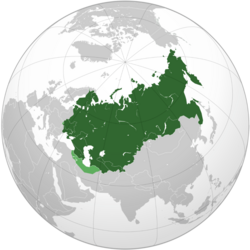
Back الجمهورية الروسية Arabic الجمهوريه الروسيه ARZ روس جومهوریتی AZB Рәсәй республикаһы BA Расійская рэспубліка BE Расейская рэспубліка BE-X-OLD Руска република Bulgarian Орос Улас (1917) BXR Ruská republika Czech Russiske Republik Danish
| History of Russia |
|---|
 |
|
|
The Russian Republic,[f] referred to as the Russian Democratic Federal Republic[g] in the 1918 Constitution, was a short-lived state which controlled, de jure, the territory of the former Russian Empire after its proclamation by the Russian Provisional Government on 1 September (14 September, N.S.) 1917 in a decree signed by Alexander Kerensky as Minister-Chairman and Alexander Zarudny as Minister of Justice.[1]
The government of the Russian Republic was dissolved after the Bolsheviks seized power by force on 7 November 1917. Nonetheless, a partially democratic election of the Constituent Assembly still took place later in November. On 18 January 1918, this assembly issued a decree, proclaiming Russia a democratic federal republic, but was also dissolved by the Bolsheviks on the next day after the proclamation.[2]
The Bolsheviks also used the name "Russian Republic" until the official name "Russian Socialist Federative Soviet Republic" was adopted in the Constitution of July 1918. The term is sometimes used erroneously for the period between the abdication of the Emperor Nicholas II on 3 March 1917 (16 March, N.S.) and the declaration of the Russian Republic in September. However, during that period the status of the Russian political system was unresolved, left up to be decided by a future elected Constituent Assembly.[3]
Cite error: There are <ref group=lower-alpha> tags or {{efn}} templates on this page, but the references will not show without a {{reflist|group=lower-alpha}} template or {{notelist}} template (see the help page).
- ^ The Russian Republic Proclaimed at prlib.ru, accessed 12 June 2017
- ^ Ikov, Marat Sal. "Round Table the Influence of National Relations on the Development of the Federative State Structure and on the Social and Political Realities of the Russian Federation". Prof.Msu.RU. Retrieved 9 February 2021.
However, historically, the first proclamation of the federation was made somewhat earlier - by the Constituent Assembly of Russia. In his short resolution of January 6 (18), 1918, the following was enshrined: "In the name of the peoples, the state of the Russian constituent, the All-Russian Constituent Assembly decides: the Russian state is proclaimed by the Russian Democratic Federal Republic, uniting peoples and regions in an indissoluble union, within the limits established by the federal constitution, Of course, the above resolution, which did not thoroughly regulate the entire system of federal relations, was not considered by the authorities as having legal force, especially after the dissolution of the Constituent Assembly.
- ^ Beevor, Antony (2022). Russia: Revolution and Civil War, 1917–1921. Penguin. p. 46. ISBN 9780593493885.



